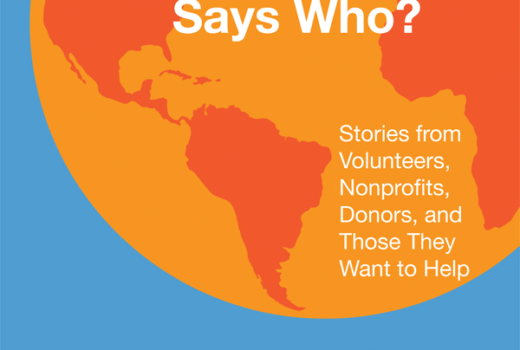 Doing Good … Says Who? Stories from Volunteers, Nonprofit, Donors and Those They Want to Help; Connie Newton and Fran Early; Two Harbors Press; Minneapolis; 2015
Doing Good … Says Who? Stories from Volunteers, Nonprofit, Donors and Those They Want to Help; Connie Newton and Fran Early; Two Harbors Press; Minneapolis; 2015
Community service is on the rise in higher education. Traditional concepts of charity are being challenged in service learning programs, in international development and social work classes as well as divinity schools. Increasing numbers of students are volunteering for a week, a summer or a semester both at home and abroad. Smart, caring young people are off to save the world.
Many faculty and community service directors struggle with how to make the field experience beneficial for the student as well as for the individuals or communities being served. Equally important is how to get across the complexities of effective community engagement and the challenges of working in a culture not one’s own.
Doing Good … Says Who? is an excellent source for creating meaningful service reflection. It provides faculty with tools to provoke thinking on the value of humility and curiosity, on meeting people where they are, on how to guide good intentions into productive outcomes. It fills a gap between the academic and the “how to” genres because it employs storytelling to engage the reader. Each story illustrates a guiding principle that the reader can apply situationally. The principles, as explained in the book’s intro:
Respect and Value the People. The reader will explore what a Maya woman with a sixth-grade education can teach a donor who approaches poverty with Handi Wipes and a retired U.S. school principal with years dedicated to helping Guatemalan school children. The three of them work together to create a nutrition program that changes the lives of mothers and children in remote mountain villages, despite the challenges that come with change.
Build Trust through Relationships. When a young Maya mother and her baby die in childbirth, tensions rise among older and younger generations, within families, and among local midwives. Will the new clinic be able to bridge these differences? The reader will follow a young volunteer through the ups and downs of building trust in the community, and in keeping well-meaning, short-term medical volunteers tuned to the local culture, rather than their imported standards.
Do “With” Rather than “For.” How much can campesinos in a coffee cooperative, an impoverished Maya mother with a microloan, and a Maya community working together on a reforestation project do for themselves? How do donors see their work? The reader will struggle with a man visiting with a group of business professionals, as he confronts the unintended consequences of his generous handout of $10,000. Where will this money go and why?
Ensure Feedback and Accountability. The board of a microfinance organization has done everything right . . . research, expert advice and due diligence. Dramatic growth is underway and from where the director and the board sit, all indicators look good. So why does the local staff tell another story? What are they seeing differently? How will it affect results?
Evaluate Every Step of the Way. A New York woman, out of her element, takes the reader along with her as she learns by trial and error … who to listen to, when to act, and how to evaluate the impact of her efforts. Why can’t she convince the curanderas (healers) to start a business based on their expertise with herbs that will increase their income? What do the curanderas see that she doesn’t?
The five chapter-length short stories are based on more than 400 interviews with volunteers, donors, NGOs and, most uniquely, with intended beneficiaries. Readers are drawn into lively experiences including operating a clinic and feeding children living in poverty in a mountain village. They will also encounter micro-lending, saving trees and promoting local industry. They will taste many of the joys, challenges and surprises that can come from trying to “do good”.
The study guide for each chapter asks the important questions that enable people to reflect on their level of respect and understanding of different cultures and approaches to community change. An appendix details the authors’ research methodology as well as their process for creating and authenticating each composite story.
Doing Good … Says Who? is must reading for anyone who is looking to deepen the impact of community service whether domestically or internationally. It is an outstanding resource for all who want to make the world a better place because its approach is experiential, illuminating successful ways to tackle the complexities of doing good well. It is a unique and valuable contribution to bringing about a more just and equitable world.
Maureen Curley is former president of Campus Compact.
Related Posts:
Does Community Engagement Have a Place in a Placeless University?
[ssba]
